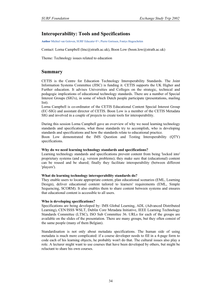Stichting SURF, de ICT-samenwerkingsorganisatie van het hoger onderwijs en onderzoek, organiseerde op 5 en 6 november 2002 de SURF Onderwijsdagen 2002, in het Nederlands Congrescentrum in Den Haag.
DOCUMENT

Stichting SURF, de ict-samenwerkingsorganisatie van het hoger onderwijs en onderzoek, organiseerde in november 2003 de SURF Onderwijsdagen 2003. De SURF Onderwijsdagen zijn bedoeld voor iedereen die betrokken is bij ict in het (hoger) onderwijs. Naast uitgebreide sessies was er een informatiemarkt waarop bedrijven en instellingen voor hoger onderwijs hun producten en diensten presenteerden. Het thema dit jaar was 'Voorbij de vernieuwing'. In zes parallelsessies vonden meer dan vijftig presentaties plaats.
DOCUMENT

For the fourth successive year SURF Educatie (SURF Education) organised the EduTrip, in which this year over 100 people from Dutch higher education and education-related businesses took part. The purpose of the Dutch visit to EDUCAUSE was first and foremost to get a shared view of the present state of affairs surrounding ICT in American institutions for higher education by means of the ability to network and establish contacts with our counterparts there. Based on this, one would subsequently be able to formulate a number of recommendations for higher education in the Netherlands.
DOCUMENT

The Learning Technology Research Institute (LTRI) and the Association for Learning Technology (ALT) are two organisations within the UK that focus on ICT in the field of learning and teaching. Chapter of report on the Exchange Study Trip 2002, organised by SURF from the 21st till the 26th of April 2002.
DOCUMENT

The Learning Technology Research Institute (LTRI) and the Association for Learning Technology (ALT) are two organisations within the UK that focus on ICT in the field of learning and teaching. Chapter of report on the Exchange Study Trip 2002, organised by SURF from the 21st till the 26th of April 2002.
DOCUMENT

The Learning Technology Research Institute (LTRI) and the Association for Learning Technology (ALT) are two organisations within the UK that focus on ICT in the field of learning and teaching. Chapter of report on the Exchange Study Trip 2002, organised by SURF from the 21st till the 26th of April 2002.
DOCUMENT

The Learning Technology Research Institute (LTRI) and the Association for Learning Technology (ALT) are two organisations within the UK that focus on ICT in the field of learning and teaching. Chapter of report on the Exchange Study Trip 2002, organised by SURF from the 21st till the 26th of April 2002.
DOCUMENT

The Learning Technology Research Institute (LTRI) and the Association for Learning Technology (ALT) are two organisations within the UK that focus on ICT in the field of learning and teaching. Chapter of report on the Exchange Study Trip 2002, organised by SURF from the 21st till the 26th of April 2002.
DOCUMENT

This study takes a valuation perspective to study how and where products and innovations are gaining ‘economic significance’ in the contemporary economy. Building on a recent research stream in economic geography and urban and regional studies, it highlights that the economic value of many products is not formed within production systems alone, but relies on co-constructed connections between production and consumption systems, playing out across multiple geographies. It distinguishes between three types of economic valuation pathways – namely technical, experiential and identity-based – which although analytically distinct may actually build and reinforce one another. This approach is empirically illustrated with the case of the surf-related economy in the city of San Sebastian (Basque Country, Spain), which is used to make a broader point about the growing relevance of a valuation approach to understand competitive advantage and economic renewal in localized production systems.
DOCUMENT